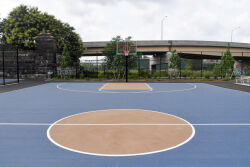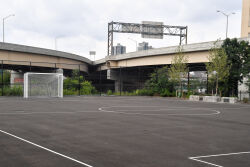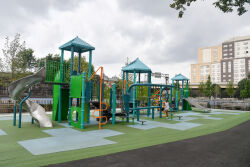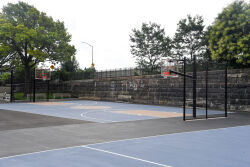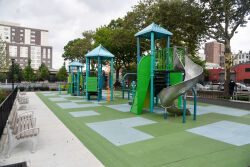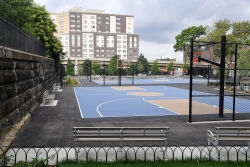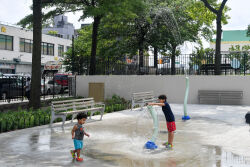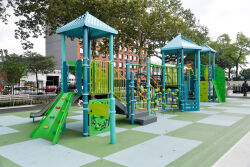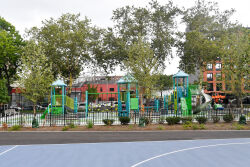Pulaski Park
Pulaski Park
What was here before?
This site was a vacant piece of land leftover from the 1904 construction of the Southern Boulevard approach to the Willis Avenue Bridge. A rise of industry in the eastern Bronx at the turn of the century brought an increased demand for a better connection between the Bronx and Manhattan. While the Third Avenue Bridge (1898) improved access between the two boroughs, it quickly became inadequate to handle the volume of traffic, necessitating a second bridge just a few blocks east. The Willis Avenue Bridge, designed by Thomas C. Clarke, opened in 1901 and provided the eastern Bronx with a much-needed second vehicular access point between the Bronx and Manhattan.
How did this site become a park?
In 1904, the City of New York acquired this property and transferred control to the Department of Bridges for use as an approach to the Willis Avenue Bridge. NYC Parks later acquired an unused 1.43 acres of this land to build a public park in 1916. In 1938, 0.76 acres was added to the park, bringing it to its current size.
The park was renovated in 1996 and 2021. The reconfigured park now features two basketball courts, a multipurpose asphalt field, and a tot lot with new play equipment.
Who is this park named for?
In 1930, this park was named in honor of Casimir Pulaski (1748-1779), a Polish patriot and military commander during the American Revolutionary War. Pulaski was born to a noble family in the present-day region of Podolia, Poland. In 1768, Pulaski and his father formed the Bar Confederation, a group of Polish nobles opposed to Russian influence. After an attempted rebellion against King Stanislaus II (1764-1795), the Confederation was suppressed by Russian troops in 1772. Pulaski, who had gained international military fame for his part in the uprising, escaped to France.
In Paris, Pulaski met with American diplomats Benjamin Franklin (1706-1790) and Silas Deane (1737-1787), who convinced him to join the American Revolution. In 1777, Pulaski arrived in Boston where he met General George Washington (1732-1799). On Washington’s recommendation, Congress commissioned Pulaski as a brigadier general of the cavalry in the Continental Army. The following year, Pulaski resigned his command and organized the Pulaski Legion cavalry unit, which fought at the Battles of Brandywine (September 1777), Germantown (October 1777), and Valley Forge (December 1777-January 1778) in Pennsylvania. In 1779, Pulaski and was mortally wounded while leading a cavalry charge into British lines in Savannah, Georgia.
In 1847, the United States government dedicated Fort Pulaski outside of Savannah, which was designated a National Monument in 1924. Pulaski was posthumously granted honorary citizenship in 2009 by the United States Congress. A memorial dedicated to Pulaski stands in Silver Lake Park, Staten Island, and there is a Pulaski Playground in Brooklyn.
Check out your park's Vital Signs
Clean & Safe
Green & Resilient
Empowered & Engaged Users
Share your feedback or learn more about how this park is part of a
Vital Park System


